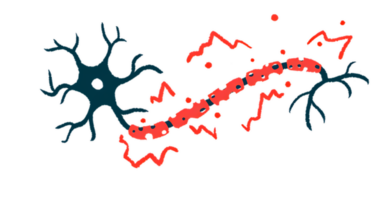Cognitive Problems May Be Due to Myelin’s Loss on Inhibitory Neurons

Myelin is required for certain inhibitory neurons — which help to suppress abnormal activity in the brain — to work as they should, according to a study in mouse models.
Loss of myelin on these neurons results in excessive electric activity in other nerve cells, likely disrupting the brain’s ability to carry out cognitive processes like encoding memories, the researchers reported.
Their findings may help to explain how cognitive problems develop in multiple sclerosis (MS), which is caused by the immune system attacking and destroying myelin.
The study, “Myelination synchronizes cortical oscillations by consolidating parvalbumin-mediated phasic inhibition,” was published in eLife.
“These results expand our understanding of the importance of myelin in [the brain] and its clinical relevance to demyelinating disorders such as multiple sclerosis,” Maarten Kole, the study’s senior author, a professor of cell biology, and group leader of the Netherlands Institute for Neuroscience, said in a press release.
Neurons, or nerve cells, have long, wire-like projections called axons, which they use to connect with other neurons. When a neuron “fires,” an electrical charge zips down the length of the axon until it reaches the end, triggering a release of signaling molecules.
The myelin sheath is a fatty covering around axons that helps them to send electrical signals more quickly, a bit like rubber insulation around a metal wire.
Researchers specifically focused on a particular class of neurons called parvalbumin-positive (PV+) interneurons. These neurons are thought to act mainly by sending inhibitory signals to other regions of the brain — in essence, telling other neurons not to fire when they aren’t supposed to.
PV+ interneurons have axons that are relatively short, and their myelin covering is “patchy” compared to other neurons, the scientists noted. Yet, the function of this unusual myelin coverage has not been clear.
To learn more, the team utilized two genetically engineered mouse models — one where the mice lacked myelin on PV+ interneurons, and one where these neurons lost their myelin over time.
Through a battery of tests, the scientists demonstrated that losing myelin did not affect the speed of inhibitory signals sent by PV+ interneurons. However, as these neurons lost their myelin, the inhibitory signals they were sending became weaker and weaker.
As a result, the mice’s brains had higher-than-normal activity, including “spikes” similar to what is seen in epilepsy. Artificially activating PV+ neurons normalized this activity, the researchers showed.
Normal brain activity takes on an “oscillatory” quality, with periods of higher activity followed by stretches of lower activity. These oscillations are necessary for important cognitive processes, like storing and retrieving memories. Epilepsy-like spikes in brain activity have been demonstrated to disrupt these processes.
As such, the researchers said their finding of spikes “may shed light on the role of PV+ axon myelination in cognitive impairments in MS.”
They added that “promoting PV+ interneuron myelination, and thereby strengthening fast inhibition, may provide important new therapeutic avenues to improve cognition.”







